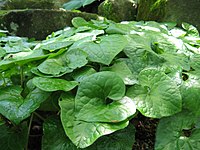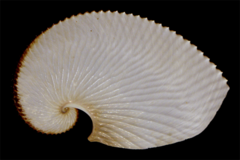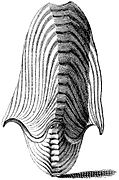Argonauta argo
| Greater argonaut | |
|---|---|

| |
| Argonauta argoinside its shell | |

| |
| Illustration fromI Cefalopodi viventi nel Golfo di Napoli(1896) | |
| Scientific classification | |
| Domain: | Eukaryota |
| Kingdom: | Animalia |
| Phylum: | Mollusca |
| Class: | Cephalopoda |
| Order: | Octopoda |
| Family: | Argonautidae |
| Genus: | Argonauta |
| Species: | A. argo
|
| Binomial name | |
| Argonauta argo | |
| Synonyms | |
|
List
| |
Argonauta argo,also known as thegreater argonaut,is aspeciesofpelagicoctopusbelonging to thegenusArgonauta.The Chinese name for this species translates as "white sea-horse's nest".[2]
A. argowas the first argonaut species to be described and is consequently thetype speciesof the genus. Thetype specimenofA. argowas collected in theMediterranean Seaand is deposited at theLinnean Society of London.[3]
Description[edit]
A. argois the largest species in the genus and also produces the largest eggcase. Live animals have a characteristic blue sheen on the firstarmpair and around theeyes.[2]The eggcase is characterised by two rows of small, sharptuberclesrunning along a narrow keel, smooth ribs across the walls of the shell, and a thickening along the shell aperture, which forms distinct protrusions or 'horns' on either side.[2]Argonauta cygnusMonterosato,1889was described based on a shell which lacked these protrusions, although it is now considered ajunior synonymofA. argo.The greatest recorded size of anA. argoeggcase is 300 mm.[4][5]
A damagedbeakof a femaleA. argo(ML = 40.0 mm; caught at20°56′N175°33′W/ 20.933°N 175.550°W), measuring 4.3 mm in hood length and 7.8 mm in crest length, is mentioned inA Handbook for the Identification of Cephalopod Beaks.[6]
Distribution and habitat[edit]
A. argois cosmopolitan, occurring intropicalandsubtropicalwaters worldwide.[2]A dwarf form exists in theMediterranean Sea,which was described asArgonauta argo mediterraneaMonterosato,1914,although thistaxonis now regarded as invalid.
Biology[edit]
The female of the species, like allargonauts,creates a paper-thin eggcase that coils around the octopus much like the way anautiluslives in itsshell,hence the namepaper nautilus.
A. argois thought to feed primarily on pelagicmolluscs.The species is preyed on by numerous predators. It has been reported in the stomach contents ofAlepisaurus feroxfrom the south-western Pacific.[7]

Males of this species reachsexual maturityat amantlelength (ML) of 8 mm.[8]Females mature at about double the size ofArgonauta bottgeriandArgonauta hians.[8]They begin to secrete an eggcase at 6.5–7.0 mm ML.[8]Eggs are usually laid when females reach 14–15 mm ML, although the size at which this takes place differs across the animal's range.[9]A smallA. argoresiding in an 88 mm long eggcase was estimated to be carrying 48,800 embryos.[10]Females grow to 100 mm ML, while males do not exceed 20 mm ML.[2]
In the open ocean,A. argohas been observed attached tojellyfish.[11]This behaviour has been known for a long time,[11][12]although little was understood about the relationship prior to the work of Heegeret al.in 1992.[13][14]In "Predation on jellyfish by the cephalopodArgonauta argo",Heegeret al.describe their observations of a femaleA. argofound atop a host jellyfish. The argonaut was seen holding on to theaboral(exumbrellar) surface of the jellyfish using its lateral and ventral arms. The authors found that about half of the animal's aboral surface was damaged and large pieces ofmesogleawere missing, presumably removed by the argonaut. Additionally, two holes, apparently bite marks, were found in the center of this area with channels leading from these holes into the gastral cavity of the jellyfish. The argonaut presumably used these channels to suck food particles from the gastral cavity. Heegeret al.suggested that "the association provided shelter or camouflage for the argonaut".[13][14]
Observations of captiveA. argofemales suggest that the expanded webs of the dorsal arms may aid the animal in feeding.Mark Normanmentions, "when food was touched against the spread webs, an arm shot out of the shell in a sweeping action, grabbing the prey".[2]Argonauts are not thought to actively hunt, but employ this method to catch animals that bump into them in the open ocean.[2]
A. argois occasionally involved in mass strandings along theSouth Africanand southernAustraliancoastlines. The strandings are seasonal and generally occur between April and August, towards the end of the animals' spawning season.
Culture[edit]



In Japanese, this species is called "Aoi-gai" (kanji:Quỳ bối,Katakana:アオイガイ[15]), which means "Shell of Aoi" (notMalvabutAsarum caulescens).[16]Japanese have compared two eggcases of argonauts lapped each other to a leaf ofAsarum caulescens.[16]Another name is "Kaidako" (kanji:Bối sao or bối tiêu,Katakana:カイダコ[15]), which means "Shell Octopus".
Gallery[edit]
-
Eggcase ofA. argo
-
Upper beak of a female
-
One of the earliest known depictions ofA. argo,fromIndex Testarum Conchyliorum(1742) byNiccolò Gualtieri
-
Illustration of a femaleA. argowithout its shell
References[edit]
- ^Allcock, L. (2014)."Argonauta argo".IUCN Red List of Threatened Species.2014:e.T163080A969616.doi:10.2305/IUCN.UK.2014-3.RLTS.T163080A969616.en.Retrieved12 November2021.
- ^abcdefgNorman, M. (2000).Cephalopods: A World Guide.ConchBooks. pp. 190–191.
- ^Current Classification of Recent CephalopodaArchivedDecember 10, 2006, at theWayback Machine
- ^Pisor, D. L. (2005).Registry of World Record Size Shells(4th ed.). Snail's Pace Productions and ConchBooks. p. 12.
- ^(in Russian)Nesis, K. N. (1982).Abridged key to the cephalopod mollusks of the world's ocean.Light and Food Industry Publishing House, Moscow, 385+ii pp. [Translated into English by B. S. Levitov, ed. by L. A. Burgess (1987),Cephalopods of the world.T. F. H. Publications, Neptune City, NJ, 351 pp.]
- ^Clarke, M. R. (1986).A Handbook for the Identification of Cephalopod Beaks.Oxford University Press. p. 244.
- ^Rancurel, P. (1970). "Les contenus stomacaux d'Alepisaurus feroxdans le sud-ouest Pacifique (Céphalopodes) ".Cah. O.R.S.T.O.M. Ser. Océanogr.(in French).8(4): 4–87.
- ^abcNaef, A. (1923). "Die Cephalopoden, Systematik".Fauna Flora Golf. Napoli (35)(in German).1:1–863.
- ^Nesis, K. N. (1977). "The biology of paper nautiluses,Argonauta boettgeriandA. hians(Cephalopoda, Octopoda), in the western Pacific and the seas of the East Indian Archipelago ".Zool. Zh.56:1004–1014.
- ^Okutani, T.; T. Kawaguchi (1983). "A mass occurrence ofArgonauta argo(Cephalopoda: Octopoda) along the coast of Shimane Prefecture, Western Japan Sea ".Venus.41:281–290.
- ^abDavid, P. M. (1965). "The surface fauna of the ocean".Endeavour.24(92). Oxford: 95–100.doi:10.1016/0160-9327(65)90007-4.
- ^Kramp, P. L. (1956). "Pelagic Fauna". In A. Bruun; S.V. Greve; H. Mielche; R. Spärck (eds.).The Galathea Deep Sea Expedition 1950-1952.pp.65–86.
- ^abHeeger, T.; U. Piatkowski & H. Möller (1992)."Predation on jellyfish by the cephalopodArgonauta argo".Marine Ecology Progress Series.88:293–296.Bibcode:1992MEPS...88..293H.doi:10.3354/meps088293.
- ^abMangold, K. M.; M. Vecchione & R. E. Young."Argonauta".Tree of Life web project.Retrieved2006-09-13.
- ^abOkutani, Takashi[in Japanese];Masaru, Tagawa; Hiroshi, Horikawa (1987).Cephalopods from Continental Shelf and Slope Around Japan: The Intensive Research of Unexploited Fishery Resource on Continental Slopes ( Nhật Bản thềm lục địa chu biên の đầu đủ loại đại lục lều mặt phẳng nghiêng chưa lợi dụng tài nguyên tinh vi điều tra ).Japan Fisheries Resource Conservation Association ( xã đoàn pháp nhân Nhật Bản thủy sản tài nguyên bảo hộ hiệp hội ). pp. 184–185.[In Japanese and English]
- ^abShinmura Izuru(2008-01-11).Quảng từ uyểnThứ sáu bản(Kōjien 6th ed.). Iwanami Shoten. p. 15 trang.ISBN9784000801218.
Further reading[edit]
- Guerra, A.; González, A.F.; Rocha, F. (2002)."Appearance of the common paper nautilusArgonauta argorelated to the increase of the sea surface temperature in the north-eastern Atlantic "(PDF).Journal of the Marine Biological Association of the UK.82(5): 855–858.doi:10.1017/S0025315402006240.hdl:10261/25147.S2CID59448557.
- Lu, C. C."Argonautidae".Australian Biological Resources Study.Retrieved2006-09-13.[permanent dead link]
- Sweeney, M. J. (2002).Taxa Associated with the Family Argonautidae Tryon, 1879.Tree of Life web project.





